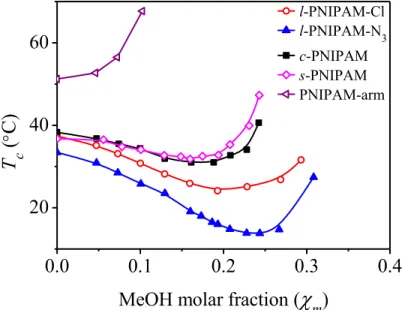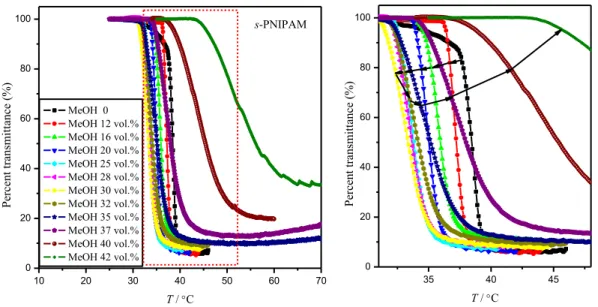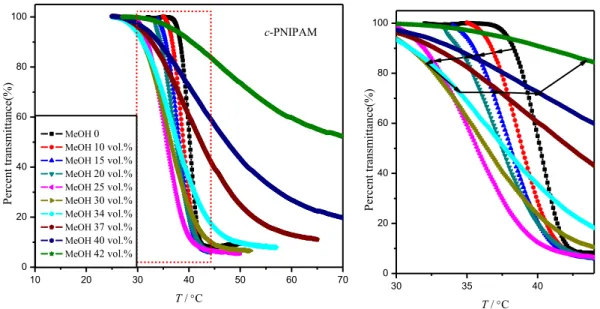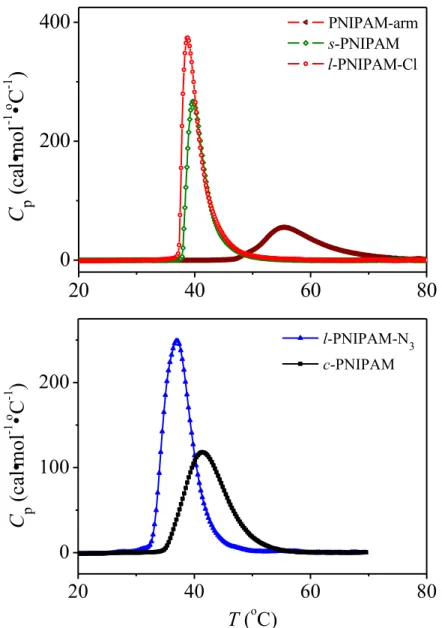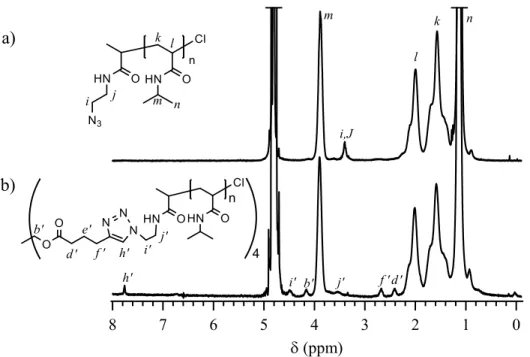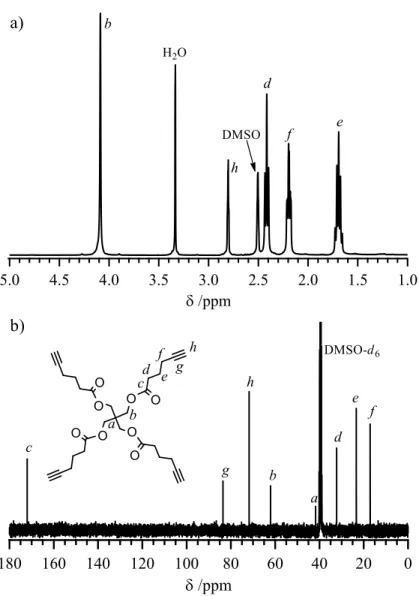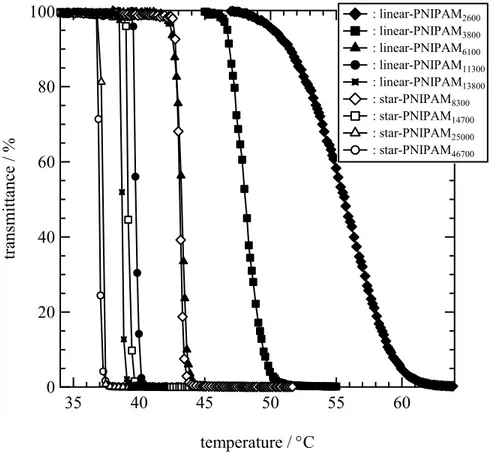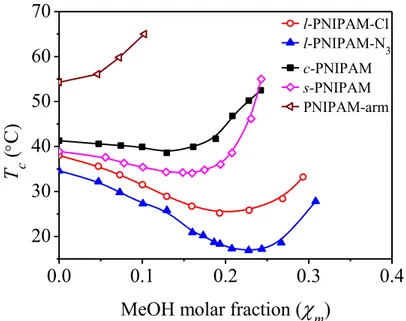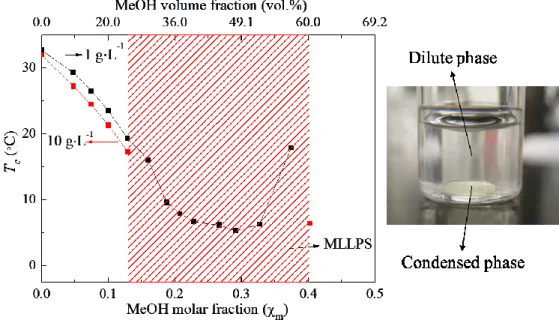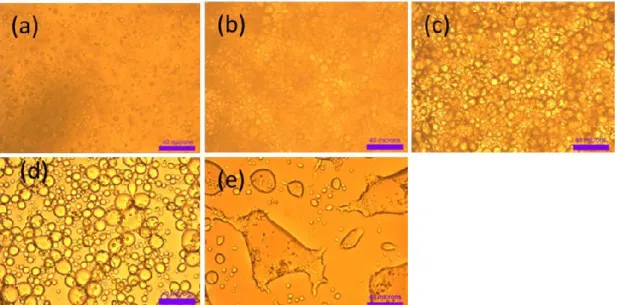Université de Montréal
The Effects of Additives and Chemical Modification on the
Solution Properties of Thermo-Sensitive Polymers
par Na Xue
Département de chimie Faculté des arts et des sciences
Thèse présentée à la Faculté des études supérieures et postdoctorales en vue de l’obtention du grade de Philosophiae Doctor (Ph.D.)
en chimie
April, 2015
Résumé
Cette thèse concerne l’étude de phase de séparation de deux polymères thermosensibles connus-poly(N-isopropylacylamide) (PNIPAM) et poly(2-isopropyl-2-oxazoline) (PIPOZ). Parmi des études variées sur ces deux polymères, il y a encore deux parties de leurs propriétés thermiques inexplicites à être étudiées. Une partie concerne l’effet de consolvant de PNIPAM dans l’eau et un autre solvant hydromiscible. L’autre est l’effet de propriétés de groupes terminaux de chaînes sur la séparation de phase de PIPOZ.
Pour ce faire, nous avons d’abord étudié l’effet de l’architecture de chaînes sur l’effet de cosolvant de PNIPAMs dans le mélange de méthanol/eau en utilisant un PNIPAM en étoile avec 4 branches et un PNIPAM cyclique comme modèles. Avec PNIPAM en étoile, l’adhérence de branches PNIPAM de à un cœur hydrophobique provoque une réduction de Tc (la température du point de turbidité) et une enthalpie plus faible de la transition de phase. En revanche, la Tc de PNIPAM en étoile dépend de la masse molaire de polymère. La coopérativité de déhydratation diminue pour PNIPAM en étoile et PNIPAM cyclique à cause de la limite topologique.
Une étude sur l’influence de concentration en polymère sur l’effet de cosolvant de PNIPAM dans le mélange méthanol/eau a montré qu’une séparation de phase liquide-liquide macroscopique (MLLPS) a lieu pour une solution de PNIPAM dans le mélange méthanol/eau avec la fraction molaire de méthanol entre 0.127 et 0.421 et la concentration en PNIPAM est constante à 10 g.L-1. Après deux jours d’équilibration à température ambiante, la suspension turbide de PNIPAM dans le mélange méthanol/eau se sépare en deux phases dont une phase possède beaucoup plus de PNIPAM que l’autre.
Un diagramme de phase qui montre la MLLPS pour le mélange PNIPAM/eau/méthanol a été établi à base de données expérimentales. La taille et la morphologie de gouttelettes dans la phase riche en polymère condensée dépendent de la fraction molaire de méthanol. Parce que la présence de méthanol influence la tension de surface des gouttelettes liquides, un équilibre lent de la séparation de phase pour PNIPAM/eau/méthanol système a été accéléré et une séparation de phase liquide-liquide macroscopique apparait.
Afin d’étudier l’effet de groupes terminaux sur les propriétés de solution de PIPOZ, deux PIPOZs téléchéliques avec groupe perfluorodécanyle (FPIPOZ) ou groupe octadécyle (C18PIPOZ) comme extrémités de chaîne ont été synthétisés. Les valeurs de Tc des polymères
téléchéliques ont beaucoup diminué par rapport à celle de PIPOZ. Des micelles stables se forment dans des solutions aqueuses de polymères téléchéliques. La micellization et la séparation de phase de ces polymères dans l’eau ont été étudiées. La séparation de phase de PIPOZs téléchéliques suit le mécanisme de MLLPS. Des différences en tailles de gouttelettes formées à l’intérieur de solutions de deux polymères ont été observées. Pour étudier profondément les différences dans le comportement d’association entre deux polymères téléchéliques, les intensités des signaux de polymères correspondants et les temps de relaxation T1, T2 ont été mesurés. Des valeurs de T2 de protons correspondants aux IPOZs sont
plus hautes.
Mots-clés : transition de phase, séparation de phase liquide-liquide, téléchélique, relaxation RMN
Abstract
This thesis focused on the phase separation of two well-known thermoresponsive polymers, namely PNIPAM (poly(N-isopropylacrylamide)) and PIPOZ (poly(2-isopropyl-2-oxazoline). Despite various studies of the two polymers, two aspects of their thermal properties remained unclear and needed to be investigated. One is the cononsolvency effect of PNIPAM in water and a second water miscible solvent. The other is the effect of the end group properties on the phase separation of PIPOZ.
With this in mind, we first studied the effect of the chain architecture on the cononsolvency of PNIPAM in water/methanol mixture, employing a 4-arm star shape PNIPAM and a cyclic PNIPAM as model. Tethering PNIPAM arms to a hydrophobic core resulted in a reduced Tc (cloud point temperature) and a lower phase transition enthalpy change. The Tc of the star shape PNIPAM was inversely dependent on the polymer molecular weight. The dehydration cooperativity was depressed for the star PNIPAM and cyclic PNIPAM due to topological constraints.
A study of the effect of polymer concentration on the cononsolvency of PNIPAM in water/methanol mixture revealed a macroscopic liquid-liquid phase separation (MLLPS) for PNIPAM in water/methanol mixtures of methanol molar fraction ranging from 0.127 to 0.421 at a polymer concentration of 10 g·L-1. The turbid suspension of PNIPAM/water/methanol separated into a polymer rich phase coexisting with a polymer poor solution phase after equilibration for two days at room temperature. The phase diagram showing the MLLPS for the PNIPAM/water/methanol mixtures was constructed based on experimental data. The droplets in the condensed polymer rich phase showed a dependence on the methanol molar fraction. Methanol affects the surface tension of the liquid droplets. The slow equilibrium kinetics of PNIPAM phase separation was sped up and a macroscopic liquid-liquid phase separation realized.
In order to study the effect of end groups on the solution properties of PIPOZ, two telechelic PIPOZ end capped with perfluorodecanyl groups (FPIPOZ) and octadecyl groups (C18PIPOZ), respectively, were synthesized. The Tc values of the telechelic polymers were
the telechelic polymers. The micellization and phase separation of the telechelic polymers in water were studied. The phase separation of the telechelic PIPOZs in water followed a liquid-liquid phase separation mechanism. Differences in the sizes of droplets formed inside of the two polymer solutions were observed. To further investigate the differences in the association behaviour between the two telechelic polymer, NMR signal intensities and T1 and T2
relaxation times were examined. Higher 1H T2 values were obtained for the IPOZ unit in
FPIPOZ than that in C18PIPOZ, indicating a higher mobility of the main chain in the FPIPOZ
micelles than that in the C18PIPOZ micelles. Together with the 13C NMR and 19F NMR
relaxation studies, we obtained better knowledge of the association properties of the telechelic PIPOZ in water. NMR relaxation studies proved to be efficient way of probing the solution behaviour of the polymers.
Table of contents
Résumé ... ii Abstract ... iv Table of contents ... vi List of tables ... x List of figures ... xi List of schemes ... xvList of abbrevations... xvi
Acknowledgment ... xviii
Chapter 1. Introduction and Literature Review ... 1
1.1 Thermoresponsive smart materials ― PNIPAM and PIPOZ ... 1
1.2 Effects of additives on the solution properties of PNIPAM and PIPOZ ... 6
1.2.1 Effect of addition of a water-miscible solvent on the solution properties of PNIPAM in water... 6
1.2.2 Effect of addition of water-miscible solvents on the solution properties of PIPOZ 10 1.2.3 Effect of other additives – salts, surfactant ... 11
1.3 Effect of end group modification on the solution properties of PNIPAM and PIPOZ ... 13
1.3.1 Synthesis of telechelic and semitelechelic amphiphilic polymers ... 13
1.3.2 Effects of hydrophilic end groups and of the length of polymer chains on the solution phase transition of amphiphilic polymers ... 22
1.3.3 Influence of the alkyl end groups on the phase transition of polymer ... 26
1.4 Techniques ... 36 1.4.1 NMR ... 36 1.4.2 Light Scattering ... 39 1.4.3 Fluorescence ... 40 1.5 Objectives ... 42 1.6 References ... 43
Chapter 2. Effect of chain architecture on the phase transitions of star PNIPAM and cyclic PNIPAM in water and in the water/methanol mixture. ... 49
2.1 Introduction ... 49
2.2 Experimental section ... 53
2.2.1 Materials ... 53
2.2.2 Instrumentation ... 53
2.3 Results ... 55
2.3.1 Phase separation of star PNIPAM in water/methanol mixtures... 57
2.3.2 Phase separation of cyclic PNIPAM in water/methanol mixtures ... 60
2.4 Conclusions ... 67
2.5 References ... 68
2.6 Appendix ... 70
2.6.1 Experimental details for synthesis of star and linear PNIPAM ... 70
2.6.2 Synthesis of N3-PNIPAM ... 74
2.6.3 Syntheses of star- and linear-PNIPAMs ... 75
2.6.4 Phase separation of star PNIPAM in water... 81
Chapter 3. Liquid liquid phase separation in poly(N-isopropylacrylamide)/water/methanol mixture ... 85
3.1 Introduction ... 85
3.2 Experimental section ... 87
3.2.1 Materials ... 87
3.2.2 Characterization methods... 87
3.3 Results and discussion ... 90
3.3.1 Phase diagram ... 90
3.3.2 MLLPS at room temperature ... 94
3.3.3 Temperature responses of the condensed phase ... 100
3.4 Conclusions ... 103
3.5 References ... 103
3.6 Appendix ... 104
Chapter 4. Synthesis and solution properties of telechelic poly(2-alkyl-2-oxazoline)s bearing perfluorodecanyl and octadecyl end groups ... 105
4.1 Introduction ... 105
4.2.1 Materials ... 107
4.2.2 Instrumentation ... 107
4.2.3 Synthesis ... 111
4.3 Results and discussion ... 113
4.3.1 Synthesis of N3PIPOZ... 113
4.3.2 Synthesis of FPIPOZ and C18PIPOZ ... 116
4.3.3 Association of FPIPOZ and C18PIPOZ in water at room temperature. ... 117
4.3.4 Thermo responses of FPIPOZ and C18PIPOZ micelles in water ... 123
4.4 Conclusions ... 132
4.5 References ... 133
4.6 Appendix ... 136
Chapter 5. Studies of the influence of end group modification on the phase separation behaviour of poly(2-isopropyl-2-oxazoline) in D2O solutions NMR Spectroscopy ... 139
5.1 Introduction ... 139
5.2 Experimental Section ... 141
5.2.1 Materials ... 141
5.2.2 Instrumentation ... 142
5.3 Results and discussion ... 143
5.3.1 1H NMR of N3PIPOZ and telechelic PIPOZs at different temperatures ... 143
5.3.2 13C NMR spectra of N3PIPOZ and telechelic PIPOZs ... 155
5.3.3 13C NMR T1, T2 of PIPOZ and FPIPOZ ... 157
5.3.4 19F NMR spectra of the FPIPOZ in D2O solutions ... 159
5.4 Conclusions ... 162
5.5 References ... 163
5.6 Appendix ... 164
Chapter 6. Conclusions and future work ... 176
6.1 Conclusions ... 176
6.1.1 Influence of chain architetecture on the phase separation of PNIPAM ... 176
6.1.2 Influence of polymer concentration on the phase separation of PNIPAM in water/methanol mixture ... 177
6.2 Future work ... 181 6.3 References. ... 182
List of tables
Table 1.1 A summary of the methods used for the synthesis of telechelic α,ω-
difunctional PEO ... 16
Table 1.2 A summary of the methods used for the synthesis of telechelic PNIPAM ... 20
Table 1.3 Synthesis routes for POZ. ... 21
Table 1.4 LCSTs of PNIPAM and PIPOZ end capped with hydrophilic end groups. ... 24
Table 1.5 Association parameters of telechelic PEO/PNIPAM/POZ with identical end groups in water. ... 34
Table 2.1 Thermodynamic parameters of the coil-to-globule transition of PNIPAM ... 56
Table A2.1 Results of ATRP of NIPAM using N-(2-azidoethyl)-2-chloropropionamide (AECP) as an initiator in 2-propanol. ... 74
Table A2.2 Physical properties of linear-PNIPAM and star PNIPAM. ... 78
Table 3.1 The methanol volume fractions ϕ in both polymer-rich phase and polymer-poor phase after MLLPS of nBu-PNIPAM in methanol/water mixtures. ... 92
Table A3.1 Density of the polymer-rich phase after MLLPS in MeOH/H2O mixtures of nBu-PNIPAM. ... 104
Table 4.1 Polymerization and molecular weight characterizations of N3PIPOZ ... 114
Table 4.2 Characterization of N3PIPOZ, FPIPOZ and C18PIPOZ ... 117
Table 4.3 Physical data for FPIPOZ and C18PIPOZ micelles in aqueous solution ... 123
Table 4.4 Thermodynamic parameters of the phase transition of N3PIPOZ and telechelic FPIPOZ and C18PIPOZ ... 132
Table 5.1 Fitting parameters for 1H T1 using equation (5.3) and (5.4) for N3PIPOZ, FPIPOZ, and C18PIPOZ. ... 150
List of figures
Figure 1.1 (a) The cloud point temperature of PNIPAM in water as a function of polymer
concentration, and (b) as a function of monomer concentration (Mn = 2.1 kDa). ... 3
Figure 1.2 Phase diagram of PNIPAM in water/methanol. ... 7
Figure 1.3 Influence of salts on the cloud points of PIPOZ.. ... 12
Figure 2.1 Phase diagram of PNIPAMs (1.0 g·L-1) as a function of solvent composition in methanol-water mixtures expressed in methanol (MeOH) molar fraction. ... 58
Figure 2.2 Temperature dependencies of the turbidity at a heating rate of 0.2 °C·min-1 for s-PNIPAM (1.0 g·L-1) in methanol/water mixtures. . ... 59
Figure 2.3 Temperature dependencies of the turbidity at a heating rate of 0.2 °C·min-1 for l-PNIPAM-Cl (1.0 g·L-1) in methanol/water mixtures. ... 59
Figure 2.4 Temperature dependencies of the turbidity at a heating rate of 0.2 °C·min-1 for c-PNIPAM (1.0 g·L-1) in methanol/water mixtures. ... 60
Figure 2.5 Heat capacity of s-PNIPAM, l-PNIPAM-Cl, and PNIPAM-arm, c-PNIPAM and l-PNIPAM-N3 in water (1.0 g·L-1) upon heating rate of 1.0 ºC·min-1. ... 63
Figure 2.6 Temperature dependence of light scattering intensity for the studied polymers at concentrations of 0.09 g·L-1. . ... 66
Figure 2.7 The size of aggregates for the polymers in water at a concentration of 0.09 g·L-1... 67
Figure A2.1 SEC traces of a) N3-PNIPAM3300 and b) star-PNIPAM14700 measured in DMF containing 0.01 mol·L-1 LiCl. ... 75
Figure A2.2 The 1H NMR spectra of a) N3-PNIPAM5800 and b) star-PNIPAM25000 in D2O. ... 76
Figure A2.3 IR spectra of a) N3-PNIAPM3300 and b) star-PNIPAM14700. ... 77
Figure A2.4 The a) 1H and b) 13C NMR spectra of pentaerythrityl tetra-5-hexynoate (1) in DMSO-d6. ... 79
Figure A2.5 IR spectra of a) N3-PNIAPM2100 and b) linear-PNIPAM2600. ... 80
Figure A2.6 1H NMR spectra of N3-PNIAPM2100 and linear-PNIPAM2600 in D2O. ... 80
Figure A2.8 The critical phase separation temperature versus molecular weight (Mn,NMR)
of N3-PNIPAM, linear-PNIPAM and star-PNIPAM in H2O. ... 82
Figure A2.9 Temperature dependence of the turbidity for (a) l-PNIPAM-N3, and (b)
PNIPAM-arm (1.0 g·L-1) in methanol/water mixtures. ... 83 Figure A2.10 Phase diagram of PNIPAM (1.0 g·L-1) as a function of solvent composition in methanol-water mixtures expressed in methanol (MeOH) molar fraction. ... 84 Figure 3.1 Phase diagram of nBu-PNIPAM in methanol/water with a polymer concentration of 1 g·L-1and 10 g·L-1. ... 91 Figure 3.2 1H NMR spectrum of the polymer poor phase and the polymer rich phase in D2O of nBu-PNIPAM/water/methanol mixed solution after MLLPS. ... 92
Figure 3.3 Phase diagram of nBu-PNIPAM/water/methanol at 21 °C. The data points represent the composition of the binodal boundary data points. ... 93 Figure 3.4 Microscopy images of nBu-PNIPAM methanol/water solution with methanol molar composition 0.308 as a function of time... 95 Figure 3.5 Microscopy images of nBu-PNIPAM/MeOH/H2O solution with different
MeOH molar fraction. ... 95 Figure 3.6 Microscopy images of PNIPAM-180K MeOH/H2O solution with MeOH
molar composition 0.453 as a function of time... 96 Figure 3.7 Optical images of PNIPAM180K methanol/water solution with different methanol molar composition... 97 Figure 3.8 Radius of droplets in nBu-PNIPAM methanol/water solutions as a function of time. Methanol molar fraction χm = 0.127, 0.308 and 0.400. ... 98
Figure 3.9 Microscopy images under 10 times magnification for nBu-PNIPAM MeOH/H2O solutions in capillaries incubated at 21 °C for 2 days.. ... 99
Figure 3.10 Microscopy images under 10 times magnification for PNIPAM-180K MeOH/H2O solutions in capillaries incubated at 21 °C for 2 days. ... 100
Figure 3.11 Microscopy images of nBu-PNIPAM MeOH/H2O mixture with MeOH
molar fraction 0.267 at different temperatures.. ... 101 Figure 3.12 Microscopy images of nBu-PNIPAM MeOH/H2O solution with different
MeOH molar fraction as a function of time. ... 102 Figure 4.1 FT-IR spectra of telechelic FPIPOZ, C18PIPOZ and N3PIPOZ. ... 115
Figure 4.2 1H NMR spectra of N3PIPOZ, FPIPOZ and telechelic C18PIPOZ (upper panel)
in CDCl3. . ... 116
Figure 4.3 Changes in the ratio I1/I3 of of pyrene and in the scattering intensity of
assemblies as a function of polymer concentration. ... 119 Figure 4.4 The RH distribution of FPIPOZ and C18PIPOZ micelles in aqueous solutions
with polymer concentration 2.5 to 10.0 g·L-1 at 20 C. ... 121 Figure 4.5 Optical transmittance of FPIPOZ, C18PIPOZ and N3PIPOZ aqueous solutions
(polymer concentration 1‒0.05 g·L-1) ... 124 Figure 4.6 The RH, Rg and Rg/RH for FPIPOZ and C18PIPOZ in water as a function of
temperature (polymer concentration 0.5 g·L-1). ... 126 Figure 4.7 Reciprocal of the theoretical scattering functions for particles of basic shapes as a function of q2. ... 127 Figure 4.8 Optical images of C18PIPOZ aqueous solution (Cpolymer = 0.5 g·L-1) on a glass
slide at different temperatures. ... 129 Figure 4.9 DSC results of FPIPOZ and C18PIPOZ aqueous solution with polymer
concentration 10 g·L-1. ... 130 Figure A4.1 Kinetic plot of IPOZ polymerization initiated by diethylene glycol
di(p-toluenesulfonate) in acetonitrile at 65 C. ... 136 Figure A4.2 GPC traces of N3PIPOZ, FPIPOZ and C18PIPOZ in DMF. ... 136
Figure A4.3 Emission spectra of pyrene as a function of polymer concentration in FPIPOZ and C18PIPOZ aqueous solutions. (Cpolymer = 0.001‒3.0 g·L-1). ... 137
Figure A4.4 TEM micrograph of telechelic FPIPOZ (Cpolymer = 0.1 g·L-1). ... 137
Figure 5.1 1H NMR spectra of N3PIPOZ (a), FPIPOZ (b) and C18PIPOZ (c) in D2O
solutions with polymer concentration 1.0 g·L-1 at 5‒70 ºC. ... 144 Figure 5.2 1H NMR integrals of different chemcial groups of N3PIPOZ, FPIPOZ and
C18PIPOZ in D2O solutions as a function of temperature... 145
Figure 5.3 1H NMR T1 times of CH2, CH and CH3 groups of N3PIPOZ, FPIPOZ, and
C18PIPOZ in D2O solution at different temperatures. ... 147
Figure 5.4 Theoretical calculated and experimental 1H NMR T1 times of CH2, CH and
Figure 5.5 Temperature dependence of the correlation time τc calculated using the τ0 and
Ea obtained from fitting of T1. ... 151
Figure 5.6 1H NMR T2 times of N3PIPOZ (a), FPIPOZ (b), and C18PIPOZ (c) in D2O
solution (Cpolymer = 10 g·L-1) at different temperatures. ... 153
Figure 5.7 The amplitude of short 1H T2 times in FPIPOZ and C18PIPOZ solutions
(Cpolymer = 10 g·L-1) as a function of temperature. ... 155
Figure 5.8 13C NMR spectra of N
3PIPOZ (a), FPIPOZ (b) and C18PIPOZ (c) in D2O
solution (Cpolymer = 10 g·L-1) at different temperatures. ... 157
Figure 5.9 13C NMR T1 and T2 times of N3PIPOZ, FPIPOZ and C18PIPOZ in D2O
solutions (Cpolymer = 10 g·L-1) as a function of temperature. ... 158
Figure 5.10 13C NMR T1 (left) and T2 (right) times of CH3 in N3PIPOZ, FPIPOZ and
C18PIPOZ D2O solutions (Cpolymer = 10 g·L-1) at different temperatures. ... 159
Figure 5.11 19F NMR spectra of telechelic FPIPOZ in D2O (Cpolymer = 10 g·L-1). ... 160
Figure 5.12 Integral of peaks in the 19F NMR spectra of telechelic FPIPOZ in D2O
(Cpolymer = 10 g·L-1). ... 161
Figure 5.13 19F NMR T1 of CF3 and T2 of fluorinated end groups for FPIPOZ in D2O
solutions (Cpolymer = 10 g·L-1). ... 162
Figure A5.1 1H NMR T1 relaxation decays of CH2, CH and CH3 of isopropyl acrylamide
group of N3PIPOZ in D2O solution at different temperatures. ... 165
Figure A5.2 1H NMR T1 relaxation decays of CH2, CH and CH3 of isopropyl acrylamide
group of FPIPOZ in D2O solution at different temperatures. ... 166
Figure A5.3 1H NMR T1 relaxation decays of CH2, CH and CH3 of isopropyl acrylamide
group of C18PIPOZ in D2O solution at different temperatures. ... 167
Figure A5.4 1H NMR T2 relaxation decays of CH2, CH and CH3 of isopropyl acrylamide
group of N3PIPOZ in D2O solution at different temperatures. ... 168
Figure A5.5 1H NMR T2 relaxation decays of CH2, CH and CH3 of isopropyl acrylamide
group of FPIPOZ in D2O solution at different temperatures. ... 169
Figure A5.6 1H NMR T2 relaxation decays of CH2, CH and CH3 of isopropyl acrylamide
group of C18PIPOZ in D2O solution at different temperatures. ... 170
Figure A5.7 1H NMR T1 relaxation times of CH2, CH and CH3 of isopropyl acrylamide
Figure A5.8 1H NMR T1 times of CH2, CH and CH3 of isopropyl acrylamide groups of
C18PIPOZ in D2O solution (Cpolymer = 1.0 g·L-1) at different temperatures. ... 172
Figure A5.9 1H NMR T2 times of CH2, CH and CH3 of isopropyl acrylamide groups of
FPIPOZ in D2O solution (Cpolymer = 1.0 g·L-1) at different temperatures. ... 172
Figure A5.10 1H NMR T2 times of CH2, CH and CH3 of isopropyl acrylamide groups of
C18PIPOZ in D2O solution (Cpolymer = 1.0 g·L-1) at different temperatures. ... 173
Figure A5.11 1H NMR T
1 (a), T2 (b) times of N3PIPOZ in D2O solution (Cpolymer = 10
g·L-1) at 60 ºC as a function of time... 174 Figure A5.12 1H NMR T1(a), T2(b) relaxation times of FPIPOZ in D2O solution with
Cpolymer = 10 g·L-1 at 60 ºC as a function of time. ... 175
Figure 6.1 Phase diagram of N3PIPOZ-7K, N3PIPOZ-11K, and FPIPOZ-7K in
List of schemes
Scheme 1.1 Representation of the phase transition of PNIPAM in water... 2
Scheme 1.2 Structure of PNIPAM and PIPOZ. ... 4
Scheme 1.3 Change in conformation of PIPOZ segment in aqueous solutions. ... 5
Scheme 1.4 Structures of PPhOZ, PEOZ80-stat-PPhOZ20, PEOZ and PNonOZ... 10
Scheme 1.5 Structure of HEUR... 14
Scheme 1.6 Synthesis of telechelic PEO using alkyl isocyanates. ... 14
Scheme 1.7 Synthesis of telechelic PEO using alkyl tosylates. ... 15
Scheme 1.8 Synthetic route of the C18-PNIPAM-C18 by RAFT. ... 17
Scheme 1.9 Synthetic route of the telechelic α,ω-di-cholesteryl PNIPAM. ... 18
Scheme 1.10 Synthetic route of the α-folate ω-dodecyl telechelic PNIPAM. ... 19
Scheme 1.11 Synthetic route to asymmetric telechelic PMOZ. ... 22
Scheme 1.12 Synthetic route to telechelic PMOZ... 22
Scheme 1.13 Aggregation pathways for telechelic PEOs. ... 28
Scheme A2.1 Synthesis of pentaerythrityl tetra-5-hexynoate (1). ... 72
Scheme A2.2 Synthesis of azido end-functionalized poly(N-isopropyl acrylamide) (N3 -PNIPAM). ... 73
Scheme A2.3 Syntheses of star- and linear-PNIPAMs by the reactions of clickable N3 -PNIPAM with pentaerythrityl tetra-5-hexynoate and ethyl 5-hexynoate. ... 73
Scheme 3.1 Right triangle three-component phase diagram. ... 86
Scheme 4.1 Synthetic procedure of , -diperfluorodecanyl poly(2-isopropyl-2-oxazoline) and , -dioctadecanyl poly(2-isopropyl-2-poly(2-isopropyl-2-oxazoline). ... 113
List of abbrevations
ATRP atom transfer radical polymerization cac critical aggregation concentration CMC critical micelle concentrationc-PNIPAM cyclic PNIPAM
CROP cationic ring opening polymerization
CTA chain transfer agent
Ð dispersity
DLS dynamic light scattering
DMAP 4-dimethylaminopyridine
DPMK
Ea
di(phenylmethyl) potassium acitivation energy
HEUR hydrophobically modified ethoxylated urethane HPLC high performance liquid chromatography
HS-DSC high sensitive differential scanning microcalorimeter
IPDU isophorone diurethane
LCST lower critical solution temperature
l-PNIPAM-Cl linear PNIPAM carrying Cl end groups
l-PNIPAM-N3 linear PNIPAM having azide group at one end
LS light scattering
MLLPS macroscopic liquid liquid phase separation NIPAM N-isopropylacrylamide
NMR Nuclear magnetic resonance
PEO polyethyleneglycol
PEOZ poly(2-ethyl-2-oxazoline) PGSE pulse-gradient spin-echo PIPOZ poly(2-isopropyl-2-oxazoline) PMMA poly(methylmethacrylate) PMOZ poly(2-methyl-2-oxazoline) PNIPAM poly(N-isopropylacrylamide)
PNIPAM-arm precursor PNIPAM for s-PNIPAM PNonOZ poly(2-nonyl-2-oxazoline) POZ poly(2-alkyl-oxazoline) PPhOZ poly(2-phenyl-2-oxazoline PVME poly(vinylmethylether) PVP polyvinylpyridine
RAFT reversible addition-fragmentation chain-transfer
Rg radius of gyration
RH hydrodynamic radius
ROP ring opening polymerization SANS small angle neutron scattering
SDS sodium dodecyl sulfate
SEC size exclusion chromatography SLS static light scattering
s-PNIPAM star-shaped PNIPAM
T1 longitudinal relaxation time
T2
Tc
τc
transverse relaxation time cloud point temperature correlation time
TMPS trimethylsilyl propionic acid sodium salt UCST
χm
upper critical solution temperature methanol volume fraction
Acknowledgment
I would like to thank my supervisor, Professor Françoise Winnik, for giving me the precious opportunity to carry out this research in her lab. This work would not have been possible without her support, encouragement, profound knowledge, great patience, and invaluable experience. I appreciated the helpful advice and frequent discussions, which helped to advance my research.
This work wouldn’t have been possible without the financial support from the Chemistry Department, Faculty of Arts and Science; Université de Montréal; Natural Sciences and Engineering Research Council (NSERC); and the China Scholarship Council (CSC).
I would like to thank Professor Julian Zhu for many fruitful discussions, helpful advice on the NMR studies. I appreciated his great patience and profound knowledge.
I would like to thank our collaborator, Professor Toshifumi Satoh, at Hokkaido University for the supply of the star polymer.
I am thankful to my colleagues at the Université de Montréal for their invaluable friendship and collaboration, especially Dr. Xing-Ping Qiu, who helped me a lot with the synthesis of the polymers.
I would like to express my sincere appreciation to Dr. Cedric Malveau for helping me set up the NMR experiments and useful advice.
Chapter 1. Introduction and Literature Review
1.1 Thermoresponsive smart materials ― PNIPAM and PIPOZ
Poly(N-isopropylacrylamide) (PNIPAM) is an attractive temperature responsive polymer that has been extensively studied over the past few decades. Its aqueous solution turns turbid around 32 ºC, the cloud point temperature. This reversible response to temperature changes makes PNIPAM useful in numerous applications such as optical filters, optical switches, adsorbents, drug-release devices, water purification devices, hair shading, protein immobilization, and immunoassay procedures.1-5 Hydrogels of cross linked PNIPAM or PNIPAM based systems are used as nonfouling surface coatings, drug release/delivery vehicles, enzyme stabilizers and sensors.6-8
Besides the practical applications, PNIPAM solutions have also been the subject of extensive theoretical studies from the viewpoint of polymer physics and model simulation in order to understand the coil to globule collapse. Scarpa et al.9 were the first to report in 1967 the inverse temperature solubility of PNIPAM in aqueous solution with a lower critical solution temperature (LCST) at 3l °C. The phenomenon was explained as follows: A strong interaction between water molecules is essential thermodynamically for controlling the conformations of polymer chains in aqueous solutions. PNIPAM segments of specific orientation form hydrogen bonds with the already partially ordered water molecules in aqueous solution. The hydrogen bonds between the polar amide group of the PNIPAM segments and the arranged water molecules lead to a reorientation of water molecules around the nonpolar groups. Clathrate-like clusters of water surround the hydrophobic isopropyl group of the PNIPAM side chain resulting in decreased entropy upon mixing. This phenomenon is known as the hydrophobic effect. At temperatures above the LCST, the entropy term overwhelms the exothermic enthalpy of the hydrogen bond formed between the amide group of PNIPAM and water molecules. The mixing free energy change becomes positive and phase separation happens. Large aggregates form, through hydrophobic interactions, between the dehydrated PNIPAM chains. 10, 11 The number of hydrating water molecules around each NIPAM segment was determined by dielectric relaxation measurements below the LCST.12 This number decreases sharply when the PNIPAM aqueous
solution is heated above LCST. Studies of the phase transition of PNIPAM aqueous solutions via light scattering reveals the coil-to-globule transition as shown in Scheme 1.1. The PNIPAM chain collapses at LCST through hydrogen bonding between polymer-polymer instead of polymer-water.
Stable milky suspensions are obtained above the LCST of PNIPAM in dilute aqueous solutions. The size of PNIPAM aggregates, the so-called mesoglobules, formed at temperatures above the LCST was found to be in the submicron region. The conformation of chains before and after phase transition was studied in dilute solutions by static and dynamic light scattering in order to obtain detailed information of phase transition dynamics.13 A report by Wu et al.14 revealed that the coil-to-globule phase transition of PNIPAM in dilute aqueous solution has two distinct kinetic stages with two characteristic transition times (0.1 ms and 0.8 ms, respectively). The first stage can be attributed to the nucleation and initial growth of some ―pearls‖ (contracted segments) along the chain, while the second stage includes the merging and coarsening of the ―pearls‖.
Scheme 1.1 Representation of the phase transition of PNIPAM in water.
A theory by Tanaka et al.15 has put forward the importance of the cooperative character of the PNIPAM hydration. The formation of one hydrogen bond between water and PNIPAM
chain facilitates the formation of another hydrogen bond of water to an amide. A sequence of water molecules dehydrate cooperatively, when the temperature is increased above the cloud point temperature of PNIPAM as shown in Scheme 1.1. A sharp transition around the cloud point temperature is predicted by Tanaka’s theory. Factors influencing the PNIPAM phase transition were considered, including addition of a second water miscible solvent, salts, concentration, molar mass, etc.
The effect of polymer concentration on the cloud point temperature (Tc) of PNIPAM in water has been investigated by Tong et al.16 A drop about 3 ºC was detected when the concentration of polymer increased from 5.8 to 700 g·L-1 for PNIPAM with molar mass of 49.4 kDa (Figure 1.1a). The Tc decreased from 35.2 ºC to 30.9 ºC for PNIPAM with 2.1 kDa when concentration of polymer increased from 3.7 to 73.9 g·L-1 as reported by Otake et al.17 (Figure 1.1b). Van Mele et al.18 reported a constant value of LCST for PNIPAM regardless of the polymer molar mass at the same polymer concentration (i.e. 500 g·L-1). In all these studied PNIPAM/water binary systems, steady suspensions of phase separated solutions were observed above the LCST of PNIPAM.
(a) (b)
Figure 1.1 (a) The cloud point temperature of PNIPAM in water as a function of polymer concentration (filled square, Mn = 101 kDa; open circle Mn = 49.4 kDa.). (Reprinted with
permission from Ref 16. Copyright 1999 American Chemical Society.) (b) The cloud point temperature of PNIPAM in water as a function of monomer concentration (Mn = 2.1
kDa). (Reprinted with permission from Ref 17. Copyright 1990 American Chemical Society.)
Recently, a structural isomer of PNIPAM, poly(2-isopropyl-2-oxazoline) (PIPOZ) (Scheme 1.2) is gaining increasing attention.19, 20 PIPOZ aqueous solutions possess a cloud
point temperature around 40 ºC.21, 22 In addition the polymer is non-toxic and biodegradable making it a promising material for biomedical and pharmaceutical applications. The LCST of PIPOZ was tuned by changes in end group polarity23, by the addition of salts,24 and by the polymer composition.25 Schlaad reviewed the synthesis of polyoxazolines with a special focus on the synthesis of biohybrids. A review by Hoogenboom highlights the bioapplications of polyoxazolines.26
Scheme 1.2 Structure of PNIPAM and PIPOZ.
Like its structural isomer PNIPAM, PIPOZ is highly soluble in water at room temperature, although the ternary amide in the PIPOZ main chain acts only as a proton receptor and is not effective in undergoing hydrogen bonding with water contrary to the secondary amide group of PNIPAM. PIPOZ is sometimes considered to be a pseudopeptide in view of the presence of amide group in the main chain. The tertiary nature of the polyamides and the lack of chiral centers in the PIPOZ main chain are the reasons why it cannot form distinct secondary structures via hydrogen bonding like polyleucine. Nevertheless, the polarity in the main chain and short isopropyl side chain of PIPOZ still make it water soluble. Studies of the solution properties of PIPOZ are limited when compared to PNIPAM, due to the difficulty in the ROP (ring opening polymerization) synthesis of long PIPOZ chain. Still, PIPOZ as a biocompatible polymer was introduced into some amphiphilic systems as hydrophilic and nontoxic segment. Based on the high sensitivity of the cloud point temperature of poly(N-alkyl-2-oxazoline) on the side chain length, block copolymers of PIPOZ and poly(N-alkyl-2-oxazoline)s with different side chain length were synthesized. Solution properties of these copolymers and homopolymers were examined taking into account factors such as addition of a second solvent or salts27 and chain length.24
Scheme 1.3 Change in conformation of PIPOZ segment in aqueous solutions.
The heat-induced phase transition of PIPOZ in aqueous solution is fully reversible when solutions are kept above LCST for a short time (< 2 h).28 Micrometer-sized particles composed of fiber meshes and nanofibers have been reported in studies of PIPOZ aqueous solutions subjected to a longer heating treatment.29, 30 Based on XRD and TEM results, the
authors proposed a mechanism for the crystallization process in the solution. The PIPOZ crystallization occurred through a combined mechanism involving the hydrophobic interaction between side chains and alignment of the acrylamide group. The evolution of the morphologies of the particles formed in PIPOZ aqueous solution at 60 ºC was studied by Diehl et al.28 by conventional and cryogenic scanning electron microscopy. A bicontinuous polymer
network-like structure was observed in PIPOZ solution after heating at 60 ºC for 0.5 h arising from phase separation into a polymer-rich phase and a polymer-poor phase. The bicontinuous phase collapses into individual particles composed of a porous fiber mesh after heating for 4 h at 60 ºC. Nanofibers form preferentially on the surface and eventually wrap the hollow particles like a ball of wool. The size and density of the porous fiber meshes were related to the concentrations of solutions and temperature. A liquid-liquid phase transition mechanism above the LCST was proposed by Katsumoto et al.31 for the phase separation of PIPOZ in water. A polymer rich phase and polymer lean phase coexist in the phase separated PIPOZ
aqueous solution as observed by optical microscopy. The changes of polymer chain conformation (Scheme 1.3) in the phase separation and subsequent crystallization process for PIPOZ in hot water solution were observed by IR.
1.2 Effects of additives on the solution properties of PNIPAM and
PIPOZ
Addition of various cosolutes can affect the phase behaviour of PNIPAM and PIPOZ through non-covalent bonding with the polymer or by changing the water structure. The behaviour of the polymer in solution is a result of the balance of interactions between its segments and between the segments and the solvent molecules. Any component whose hydration sphere is not compatible with the polymer depresses the LCST. If the third component has the same activity in both separating phases, the LCST increases.
1.2.1 Effect of addition of a water-miscible solvent on the solution properties
of PNIPAM in water
The phase transition of aqueous PNIPAM solutions can be affected by added solvents. Addition of a certain amount of water miscible solvent (methanol, ethanol, THF, DMSO etc.) to a clear aqueous solution of PNIPAM results in a turbid solution. The phase separated solution becomes clear again by cooling the mixtures below a certain temperature. Both water and methanol are good solvents for PNIPAM at room temperature. However, PNIPAM does not dissolve in the mixture of the two solvents. The phenomenon is known as cononsolvency. The solvent pair is called cononsolvent of PNIPAM. Figure 1.2 shows the phase diagram of PNIPAM in water/methanol mixture as an example. At 20 ºC, a clear solution is obtained when the methanol volume fraction is below 27% in the PNIPAM/water/methanol system. Increasing the methanol volume fraction to 27‒65% leads to a cloud solution. This becomes clear again upon further increasing the methanol volume fraction.
Figure 1.2 Phase diagram of PNIPAM in water/methanol. (Reprinted with permission from Ref 32. Copyright 1990 American Chemical Society.)
Different theories were proposed to interpret the phenomenon. The phase separation of PNIPAM in water-methanol mixture can be described by the changes in the balance between hydrogen bonding and hydrophobic interactions. Addition of methanol to the aqueous solution of PNIPAM destroys the hydrated water layer around PNIPAM chain. The competition between water molecules and the second solvent molecules in forming hydrogen bond along the PNIPAM main chain causes the dehydration of the polymer. The competition reaches maximum when the volume fraction of methanol is ~ 0.55 corresponding to the minimum of the phase diagram.
Wu et al.33 explained the LCST type phase transition in water/methanol mixture using the water/methanol cluster network theory. The formation of methanol-water complex in the water-methanol mixed solvent was suggested as the reason for the sudden dehydration of PNIPAM. The formation of pentagon clusters through hydrogen bonding between water and methanol molecules caused the dehydration of PNIPAM chains. The minimum of the phase diagram occurred at the point where water and methanol molecules formed stable clathrate structures. Pang's study confirmed the formation of complex structures between solvent
molecules.34 The addition of methanol reduced the interaction between PNIPAM chain and
solvents. They found that the cluster structure of the free water molecules was not affected by added methanol molecules; however the number of such structures decreased as a result of the strong interaction between the two species via hydrogen bonding. Schild et al.35 used the
Flory-Huggins ternary solution theory to explain the cononsolvency in terms of a change in the water-ethanol interaction parameter in the PNIPAM solution. The local contact between the polymer and solvent caused a perturbation of the binary interaction parameter. Tanaka et al.36 introduced a mechanism which combined the cooperativity in hydration of the PNIPAM chain and the competition of methanol and water in hydrogen bonding to the polymer. The formation of hydrogen bond of one water molecule with the PNIPAM chain displaced the isopropyl group and made it easy for the hydrogen bonding of a second water molecule. As a result, a sequence of water molecules formed along the PNIPAM chain. Added methanol molecules competed with water in the formation of hydrogen bonds. When the sequence of water molecules along the PNIPAM chain was not long enough to retain cooperativity, the chain was dehydrated and the LCST reached its minimum. The cooperativity in hydrogen bonding and competition between water and methanol led to the re-entrant curvature of the phase diagram of PNIPAM. Using molecular dynamics, Walter et al.37 investigated the cononsolvency phenomenon by molecular simulation and found that the methyl group of methanol was oriented towards the bulk solvent in the outer region of the solvent shell of PNIPAM, which caused the PNIPAM and solvent shell to become hydrophobic and collapse in the water/methanol mixture. Hao et al.38 studied the origin of cononsolvency in THF/water
mixture and concluded that the composition fluctuation which reaches the maximum at about 20 mol% THF content, induced PNIPAM cononsolvency. At the composition fluctuation maximum, neither the hydrogen bonding with water nor the Van der Waals interaction with THF was adequate to solubilize PNIPAM.
What is the effect of polymer concentration on the LCST of PNIPAM in mixtures of water/methanol? Most studies of the cononsolvency phenomenon of PNIPAM were conducted for dilute polymer solutions. So far, only a few reports are found on the phase transition in more concentrated solutions of PNIPAM in mixed solution of methanol and water. Tao’s39 study about PNIPAM at polymer concentration up to 150 g·L-1 reported a
macroscopic phase separation in the mixed solution of water and methanol. Two liquid phases were observed in the concentrated PNIPAM/water/methanol system with certain solvent composition. A very clear polymer-poor phase coexisted with a viscous polymer-rich phase. The phase demixing boundary was determined as the composition at which phase separation began. A ternary interaction parameter was considered in the PNIPAM/water/methanol system to explain the formation of ternary complexes.
A liquid-liquid phase demixing was also reported for other polymers.40, 41 The polymer
concentration has been reported to affect the solution properties of PVP, PMMA etc. in mixed solvents. Three liquid phases have been observed in a PVME/water/THF system.40 The concentration of PVME used in their work varied from 50 to 900 g·L-1. The liquid-liquid phase demixing of poly(methacrylic acid) in methacrylic acid and water mixtures was reported and the values of the parameters of the ternary version of the Cahn-Hilliard equation of spinodal decomposition were determined.41 The phase separation process of PMMA in mixed solvents of water/acetone or water/THF was studied by a solvent shifting process (also called the ―Ouzo process‖) in which water (nonsolvent) was added to a solution of PMMA/solvent system.42 Nanoparticles or microparticles were observed depending on the initial PMMA concentration and water/solvent ratio in the mixtures. The boundary between the Ouzo region of compositions (PMMA nanoparticles only), from the ―non-Ouzo‖ region (nano- and microparticles) were determined and appeared to have no relation with the spinodal decomposition line of the ternary solutions.
A study on the phase transition of PNIPAM in water/methanol mixture, taking into account the polymer concentration effect will contribute to a better understanding of the phase transition mechanism of PNIPAM. Chapter 3 of the thesis will present the phase transition behaviour of highly concentrated solutions of PNIPAM in methanol/water. The effect of other parameters such as the architecture and the polymer concentration on mixed polymer solutions are still poorly understood. The effect of polymer architecture on LCST of PNIPAM in mixed solvent of methanol and water will be addressed in Chapter 2.
1.2.2 Effect of addition of water-miscible solvents on the solution properties
of PIPOZ
There are only a few reports about the effect of addition of water-miscible solvents on the LCST phase transition of PIPOZ water solutions. The LCST of aqueous PIPOZ solution was tuned by addition of ethanol as reported by Lambermont-Thijs et al.43 The minimum LCST appeared for an ethanol composition of 5 wt% in the PIPOZ/water/ethanol mixture. However THF and water mixed solvent were a cosolvent for PIPOZ.44
A UCST (upper critical solution temperature) was observed for PPhOZ (poly(2-phenyl-2-oxazoline) in ethanol by Schubert et al.45 (Structure shown in Scheme 1.4). Addition of water to the ethanol solution of PPhOZ resulted in an increase in solubility of the polymer with a maximum in 6 ~ 25 wt% of water in ethanol. The hydrogen bonding of water with amide groups of PPhOZ formed a hydration shell around the polymer. PEOZ80
-stat-PPhOZ20 (the subscript indicates mole percent of monomer) exhibited both LCST and UCST
transitions in a water/ethanol mixture with 40 wt% ethanol.46 A UCST was also observed for
copolymers of PEOZ (poly(2-ethyl-2-oxazoline) and PNonOZ (poly(2-nonyl-2-oxazoline) in water/ethanol solvent mixtures.47
1.2.3 Effect of other additives – salts, surfactant
Besides these water-miscible solvents, salts are also known to influence the LCST. Before discussing the effect of salts on the solution behaviour of polymer, there are a few concepts that need to be clarified. The Hofmeister series is a classification of ions in the order of their ability to salt-out or salt-in proteins. Anions appear to have a larger effect than cations, and usually follow the order:
F- ≈ SO42- > HPO42- > OAc- > Cl- > NO3- > Br- > ClO3- > I- > ClO4- > SCN
-The order of cations is usually given as:
NH4+ > K+ > Na+ > Li+ > Mg2+ > Ca2+ > [C(NH2)3]+
The salts in the left part of these series decrease the solubility of nonpolar molecules. The process is known as salting-out. The salting-in process refers to the increase of the solubility of nonpolar molecules by the later salts in the series. The ions that contribute to the stability of water - water interactions and intramolecular interactions in polymers, are defined as kosmotropic ions. On the contrary, chaotropic ions disrupt the hydrogen bond between water molecules and polymer-water molecules.
The effect of a series of salts on the LCST of PNIPAM was studied by Cremer et al.48,
among others. The anions studied followed the Hofmeister series. The phase transition of PNIPAM was found to be directly correlated with the hydration entropy of the strongly hydrated anion at adequate concentration. The weakly hydrated anions exhibited salting-out effects. Bergbreiter et al.14 investigated the effect of a series of sodium salts on the LCST of
PNIPAM as a function of polymer molecular weight and polymer concentration. In concentrated solutions of strongly hydrated kosmotropic anions, the phase transition of PNIPAM consisted of two separate steps for higher molecular weight samples. The first step was found to be sensitive to the polymer molecular weight and the solution concentration, which was not observed in the second step. Interaction between the chaotropic anions and the polymer was also found to be affected by the molecular weight of PNIPAM. Wang et al.49 studied the effect of salts on the reentrant behaviour of PNIPAM in water-methanol system. SCN- and ClO4- depressed the reentrant transition, while other anions enhanced the transition.
Bloksma et al.24 investigated the effect of addition of a range of Hofmeister salts on the
LCST of PIPOZ as shown Figure 1.3. SCN-, ClO
4- , and I- showed a salting in effect, i.e., the
cloud points increased with increasing salt concentration, while Cl-, OAc-, and SO
42- , caused a
salting-out effect. The order of salting in to salting-out effect nicely followed the Hofmeister series: SCN-> ClO4- > I- > Cl- > OAc- > SO42-.
Figure 1.3 Influence of salts on the cloud points of PIPOZ. (Reprinted with permission from Ref 24. Copyright 2010 WILEY-VCH Verlag GmbH & Co. KGaA, Weinheim)
Eliassaf et al.50 were the first to report the effect of surfactant addition on phase
transition of PNIPAM employing the sodium dodecyl sulfate (SDS). The solution viscosity increased and the phase transition temperature was elevated with the addition of 1% of SDS. Schild and Tirrell51 used different fluorescent probes to investigate the PNIPAM/SDS system and observed that the critical aggregation concentrations (cac) were essentially the same in most cases. Meewes et al.52 observed that the phase transition of PNIPAM was completely prevented when SDS concentration reached 250 mg·L-1. Addition of SDS and dodecyltrimethylammonium chloride into aqueous solutions of PIPOZ caused an increase of LCST.19
1.3 Effect of end group modification on the solution properties of
PNIPAM and PIPOZ
1.3.1 Synthesis of telechelic and semitelechelic amphiphilic polymers
A telechelic polymer is defined by IUPAC as a ―prepolymer capable of entering into further polymerization via its reactive endgroups‖. Depending on the number of functionality, telechelic polymers can be classified as mono-, di- and multi- functional telechelics. In this work, only linear polymers are considered, we simply use the common name telechelic and semitelechelic to differentiate the di- and mono- end functional polymers. Amphiphilic telechelic polymers refer to polymers containing water soluble segments in the middle of the chain and hydrophobes at the chain ends which tend to associate with each other in water. The first report of telechelic polymers can be traced back to the 1970s when telechelic PVP and PEO were used as emulsifiers and thickeners.53 Most research interests have been devoted to tune the properties of telechelics by changing the chain length and structure of the central hydrophilic chain and of the hydrophobic chain ends, which provides the basis for applications as associative thickeners,53 sieving media for DNA sequencing,54 and drug delivery vehicles. The rheological behavior of telechelic polymers has been reviewed recently by Chassenieux.55 The association behaviour of end-hydrophobically-modified PEO and poly(acrylamide) are reviewed by Grassl et al.56 An extensively studied class of amphiphilic telechelic polymers are the hydrophobically end-functionalized PEO through urethane or ester linkages with hydrophobic alkyl end groups of various length and structure.57-62 The typical synthesis routes
of amphiphilic telechelic and semitelechelic PEO, PNIPAM and PIPOZ having interesting structures and stimuli responses will be discussed in this section.
1.3.1.1 Synthesis of telechelic and semitelechelic PEO
i) Alkyl isocyanate attached to α,ω-dihydroxyl PEO through urethane linkage
In the early studies, telechelic PEOs were prepared by reacting short PEO chains with isophorone diisocyanate or isophorone diurethane (IPDU) to extend the chain length and to attach end groups.63, 64, 65 These commercially available telechelic polymers, end capped with alkyl group via urethane linker, were known as HEUR (hydrophobically-modified ethoxylated
urethane) polymers (structure shown in Scheme 1.5). In the beginning, the classic step-growth reaction was employed to produce HEUR polymers with broad molecular weight distribution.
Scheme 1.5 Structure of HEUR.
The HEUR polymers containing only two urethane linkers were obtained by modification of prepared PEO bearing hydroxyl groups at both ends. Hydrocarbons with variable chain length have been attached to the PEO chain ends as shown in Table 1.1. The prevalent synthetic approach follows a two-step procedure, whereby, first, isocyanates present in excess are linked to the PEO terminal hydroxyl groups. In the second step, isocyanate-modified PEO is subjected to purification treatment to remove diurea and diurethane products due to the excess of isocyanates.66, 67 Gourier et al.68 and Beaudoin et al.69 synthesized α,ω-di-functionalized PEOs by addition of an alkyl (C16 or C12) isocyanate to α,ω-dihydroxylated
PEO in the presence of 1,4-diazobicyclo[2.2.2]octane in toluene at 30 °C as shown in Scheme 1.6.
Scheme 1.6 Synthesis of telechelic PEO using alkyl isocyanates. ii) Alkyl acid reaction with α,ω-dihydroxyl PEO
The drawback of the above method lies in the fact that even though isocyanate is in large excess in the first step of the modification procedure, it is difficult to completely avoid polycondensation leading to formation of polymers of twice the initial molecular weight. To minimize this issue, a one pot synthesis was proposed, which involved in situ generation of a hydrophobic anhydride by reaction of a carboxylic acid or an alcohol with
N,N-dicyclohexylcarbodiimide, leading to complete modification of hydroxyl end groups. Laflèche et al.70 modified the PEO by reaction of the terminal hydroxyl groups with
hexadecylchloric acid.
iii) Alkyl tosylate reaction with α,ω-potassium dialkylate-PEO
Beaudoin et al.71 synthesized α,ω-dioctadecyl-PEO and α,ω-dihexadecyl-PEO with Mn
= 32 kDa which had the same structure as described in a previous report.69 A different synthetic method was employed, in which telechelic PEOs were prepared using alkyl tosylate intermediates in two steps as shown in Scheme 1.7. First, PEO with hydroxyl end groups reacted slowly with di(phenylmethyl) potassium (DPMK) to yield α,ω-potassium dialkylate-PEO. Then dodecyl tosylate or octadecyl tosylate was introduced to obtain the final product. The telechelic PEOs with end group functionalization degree above 0.9 prepared by the alkyl tosylates method was obtained in 1 day, while it took more than 5 days to generate the telechelic PEOs with end group functionalization degree above 0.9 prepared by the alkyl isocyanate method. Using alkyl tosylates to attach hydrophobic end groups reduced the reaction time and avoided polycondensation, but there were more steps involved and it was complicated to prepare the DPMK.
Scheme 1.7 Synthesis of telechelic PEO using alkyl tosylates. iv) PEO-sodium alcoholate reaction with alkyl bromide
Renou et al.72 synthesized semitelechelic PEO by reacting the PEO-sodium alcoholate with alkyl bromide in THF (Williamson reaction). The product PEOs had a methyl group at α- end and long alkyl chains of a variety length at the ω- end. The semi-telechelic PEO was synthesized the same way as the telechelic PEO by controlling the ratio of polymer and end group modifier.71
Table 1.1 A summary of the methods used for the synthesis of telechelic α,ω- difunctional PEO
Synthesis method α,ω - functionality Mn (kDa) Ð
urethane linkages -C18H37 459 1.05 -C18H37 2058 - -C16H33 51, 67.6, 84.3, 100.460 1.7 -C16H33 -C18H37 20, 35 3561 <1.2 -C18H37 1, 2, 457 1.1 Alkyl-isocyanate reaction with HO-PEO-OH -C8H17, -C12H25, -C18H37 466 1.1 -C12H25, -C16H33 12, 20 3268 <1.1 -C16H33 3269 1.02 C16H33Cl reaction with HO-PEO–OH -C16H33 10 70 <1.1
Alkyl tosylates reaction with KO-PEO–OK -C18H37, -C12H25 35, 6, 10, 20, 3571 - PEO-sodium alcoholate
reaction with alkyl bromides
-C12H25, -C14H29, -C16H33,
-C18H37, -C20H42,
-C22H45, -CH3
4.572 1.05
1.3.1.2 Synthesis of telechelic and semitelechelic PNIPAM
Telechelic PNIPAMs capped with hydrophobic groups at each end were synthesized by RAFT (Reversible addition−fragmentation chain-transfer) polymerization. The synthesis method of PNIPAM was summarized in Table 1.2.
i) End groups induced by modified CTA
Telechelic PNIPAM end-capped with various end groups were synthesized by preparing a chain transfer agent (CTA) containing desired end groups. Kujawa et al.73
2 as shown in Scheme 1.8. The CTA 2 was prepared by a modified ketoform reaction yielding the carboxyl-terminated trithiocarbonate 1, followed by a carbonyldiimidazole-mediated amidation of the terminal carboxyl group with n-octadecylamine. RAFT polymerizations of NIPAM were then conducted to obtain telechelic PNIPAM 3 with various molecular weight and low dispersity index (< 1.2). Specially prepared CTAs with various structures have been used to synthesize telechelic PNIPAMs, such as 4’-(4-methylphenyl)-2,2':6',2''-terpyridine- 4'-yl-benzyl dithiobenzoate,74 butyl phthalimidomethyl
trithiocarbonate,75 tetrathiafulvalene trithiocarbonate,76 4-(tert-butyl)phenyl 2-(((ethylthio)carbonothioyl)thio)-2-methylpropanoate,77 and 1,4-bis(n-butylsulfanylthiocarbonylsulfanylmethyl)benzene.78
Scheme 1.8 Synthetic route of the C18-PNIPAM-C18 by RAFT. (Adapted with permission
from Ref 73. Copyright 2006 American Chemical Society.) ii) Alkyl iodides or ethers reaction with HS-PNIPAM-SH
The methodology employed above to synthesize hydrophobically end capped telechelic PNIPAMs has the disadvantage of preparation of a different CTA for each type of end group. A more efficient pathway to synthesize telechelic PNIPAMs has been reported by Qiu et al.79 The telechelic PNIPAM was prepared by coupling the alkyl iodides or ethers to the precursor polymer (HS-PNIPAM-SH) carrying mercaptan functions at each end. This strategy has been
used to synthesize dicholesteryl-PNIPAM as shown in Scheme 1.9.80 The HS-PNIPAM-SH 2
was prepared by RAFT polymerization of NIPAM using diethylene glycol di(2-(1-isobutyl)sulfanylthiocarbonylsulfanyl-2-methylpropionate) 1 as difunctional CTA, followed by aminolysis with n-butyl amine. The telechelic PNIPAM 4 was obtained by the coupling reaction of cholest-5-en-3b-yl 6-iodohexyl ether 3 and precursor polymer 2. The synthetic method in Scheme 1.9 was employed to synthesize a α,ω-diazobenzene-PNIPAM in two steps.79 A HS-PNIPAM-SH precursor polymer was first prepared the same way as shown in
Scheme 1.9. By reacting with 4-Cyano-4'-(6-iodohexyloxy)azobenzene in sodium dicarbonate DMF solution, azobenzylhexyloxy group was coupled to the thiol end group of the HS-PNIPAM-SH telechelics.
iii) Alkyl end groups attached to PNIPAM main chain by click chemistry
Another efficient method to synthesize end functionalized telechelics is the combination of RAFT polymerization and click chemistry.
Scheme 1.10 Synthetic route of the α-folate ω-dodecyl telechelic PNIPAM.
The telechelic PNIPAM 2 carrying an azido group at one end and a dodecyl group at the other end was synthesized by RAFT polymerization using 2-dodecylsulfanylthiocarbonylsulfanyl-2-methyl-propionic acid 3-azidopropyl ester as CTA 1 (Scheme 1.10).81 The RAFT polymerization was conducted in dioxane in the presence of AIBN, CTA, NIPAM with N2 purge and heating for a certain time. The same method was
employed to synthesize a telechelic PNIPAM end-capped with an azido and dodecyl groups at each teminus of Mn = 16.3 kDa using the same CTA by Li et al.82 and Vora et al.,83
respectively. The azido end group reacted with propargyl folate by click reaction to obtained the α-folate ω-dodecyl telechelic PNIPAM.82
Table 1.2 A summary of the methods used for the synthesis of telechelic PNIPAM
Synthesis method End group functionality Mn (kDa) Ð
RAFT with modified CTA
α,ω = -C18H37 12.4‒4973 <1.2 α = terpyridinyl-benzyl; ω = benzyl 1.91‒2.8674 1.06‒1.11 α = phthalimidomethyl; ω = butyl 10.675 1.07 α = tetrathiafulvalene; ω = isobutyl 1.7‒13.176 1.14‒1.3 α=-CH(CH3)2CO2Ph-tBu; ω =-C2H5 4‒5077 1.15‒1.46 α,ω = -C4H9 3978 1.5 HS-PNIPAM-SH reaction with Alkyl iodides
α,ω = -azobenzyl 10.579 1.08
α,ω = cholesteryloxyhexyl 8.8‒26.180 <1.1
RAFT and click chemistry
α= -C(CH3)CO2C3H6N3; ω = -C12H25 2781 1.15
α = Folate; ω = -C12H25 16.382 1.06
α = -OH; ω = -C12H25 4.683 1.10
1.3.1.3 Synthesis of telechelic and semitelechelic POZ
There are only a few reports (Table 1.3) on hydrophobically end capped PIPOZ. Generally the poly(2-alkyl-oxazoline) (POZ) was synthesized by cationic ring opening polymerization (CROP), and specific initiators and termination agents were chosen to supply desired hydrophobic end groups. Huber et al.23 synthesized a PIPOZ oligomer (DP = 25) with nonyl or methyl group at the α- end and a nonyl, piperidine or piperazine group at the ω- end. Nonyltriflate or methyltriflate were used as initiators so that the nonyl or methyl groups remained at one end of the PIPOZ chains. The termination agent piperidine, piperazine or nonylamine were attached to the ω- end of the PIPOZ chain. Both telechelic and semi-telechelic PIPOZ with C18H37 group attached to one end or both ends were synthesized by
Obeid et al.84 The semitelechelic PIPOZ with C
18H37 group at α- end was synthesized by
CROP using n-octadecyl-4-chlorobenzenesulfonate as initiator and methanolic KOH as termination agent. The telechelic PIPOZ was prepared starting from the semitelechelic PIPOZ and react with n-octadecyl isocyanate.
Table 1.3 Synthesis routes for POZ.
Synthesis method End group functionality Mn (kDa) Ð
CROP of PIPOZ initiator = alkyltriflate α = -C9H19 or -CH3 ω = -C9H19, piperidine/ piperazine ~323 1.04‒1.16 CROP of PIPOZ initiator=octadecyl tosylate α = -C18H37 ω = -C18H37 or -OH 7‒1384 1.06‒1.21 CROP of PMOZ
initiator = alkyl tosylate terminator = alkyl-piperidine
α = C8F17-C2H4-
ω = CnH2n+1, n=6~18
1.8‒2.285 1.15‒1.20
CROP of PMOZ Initiator = alkyl iodides Terminator = alkyl amine
α,ω = -C12H25 or
α,ω = -C18H37
2‒1486 1.1‒1.4
A telechelic asymmetric poly(2-methyl-2-oxazoline) (PMOZ) with a perfluoro alkyl group or hydrocarbon alkyl group at the α- end and a piperidine group at ω- end was synthesized by CROP by Nuyken et al.85 The hydrocarbon or fluorocarbon end group came
from the initiator and the piperidine group originated from the termination reagent. The telechelic PMOZ with C8F17-C2H4- group at α- end and a hydrocarbon group CnH2n+1 at ω- end
was synthesized as well using the same synthetic route (Scheme 1.11). Volet et al.86
synthesized a range of telechelic poly(2-methyl-2-oxazoline) (PMOZ) end capped with alkyl end groups (-C12H25 and -C18H37). The alkyl iodides as initiator and alkyl amine as terminator
were used to attach alkyl groups to the termini of the PMOZ main chain prepared by CROP as shown in Scheme 1.12.
Scheme 1.11 Synthetic route to asymmetric telechelic PMOZ.
Scheme 1.12 Synthetic route to telechelic PMOZ.
1.3.2 Effects of hydrophilic end groups and of the length of polymer chains
on the solution phase transition of amphiphilic polymers
A significant effect of the polymer end groups on the solution behaviour of PNIPAM and PIPOZ has been reported particularly for polymers of low molecular weight.87, 88 PNIPAM bearing end groups of different hydrophilic/hydrophobic balance have been synthesized,89 and their solution behaviour has been examined.87, 88 Smithenry et al.89 synthesized telechelic PNIPAMs with varying Mn 5.1‒32.3 kDa possessing carboxylic acid
(-C(CH3)(CN)-C2H4COOH) group at both ends. The LCST of carboxylic acid functionalized
PNIPAMs in aqueous solutions decreased from 31 to 29 ºC with increasing molecular weight as shown in Table 1.4. Xia et al.90 synthesized four series of PNIPAM with a propionamide or propionate group at the α- end and a chloride group at ω- end and studied the effect of end group hydrophobicity on LCST of PNIPAM. Their study revealed that the shape of the turbidity curves and the enthalpy change of phase transition were affected by the end group hydrophobicity. Sharp transitions and relatively higher LCSTs were observed for PNIPAM
with more hydrophilic end groups (propionamide and isopropionamide group), while PNIPAM with least hydrophilic end group (ethylpropionate- and phenylpropionamide group) exhibited early onsets in their turbidity curves and lower LCST. The molecular weight dependence of the cloud point was found to be more prominent for PNIPAM end modified with the most hydrophilic group. Furyk et al.91 synthesized three series of PNIPAM with different groups on α- end and a methyl group at ω- end using different initiators. Only a slight molecular weight dependence of LCST was observed within each series and the difference between LCST of PNIPAM carrying different groups was less than 1 ºC, probably due to the high molecular weight of PNIPAMs (18‒200 kDa). Wei et al.92 synthesized asymmetric PNIPAMs (Mn = 10 kDa) with a hydrophobic alkyl chain (C12H25- or C2H5-) at α-
end and a hydrophilic carboxyl acid group or phenylboronic acid group at ω- end. The phase transition of C12H25-PNIPAM exhibited a lower LCST and wider transition than that of C2H5
-PNIPAM. From all these studies, we o conclude that: 1) hydrophilic end group elevate the LCST of PNIPAM, while hydrophobic end groups depress it; 2) the effect of end group modification only interferes when the PNIPAM chain is relatively short; 3) molecular weight dependence is more prominent when the end group is less hydrophobic. A series of PNIPAM having the same Mn (7 kDa) with different end groups (hydroxyethyl, propargyl, chloroethyl,
n-butyl, n-hexyl, and isobutylsulfanylthiosulfanyl) was synthesized by Winnik et al.93 The
LCST ranged from 40.5 to 23.5 ºC as shown in Table 1.4. The effect of the end group was more prominent for lower molar mass sample.
There are a few studies of the PIPOZ end functionalized with hydrophilic groups. Meyer et al.30 synthesized a series of PIPOZ possessing 4-(N-Boc-amino)-piperidine at α- end
and methyl group at ω- end with varying polymerization degree (DP) 47‒174 (Mn 5.3‒19.7
kDa). The LCST of charged PIPOZ+ (due to the ammonium in the piperidine group) in saline solution (0.94 wt% NaCl, pH 7) decreased from 38.5 to 35.5 °C when the DP increased from 47 to 174. The larger the polymerization degree, the lower were the hydrophilicity and the LCST. A 3,3-diethoxy-propyl moiety at α- end of PIPOZ (Mn = 9.6 kDa) did not affect the
LCST of the PIPOZ compared to PIPOZ carrying methyl groups at α- end with similar molecular weight under identical measurement condition.94 The authors concluded that chain length was the determinant factor dictating the phase transition of PIPOZ. A hydrophobic
